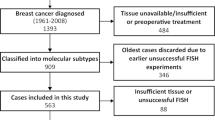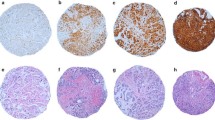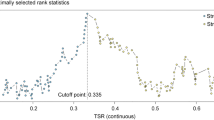Abstract
Purpose
Elevated S100A8 expression has been observed in cancers of the bladder, esophagus, colon, ovary, and breast. S100A8 is expressed by breast cancer cells as well as by infiltrating immune and myeloid cells. Here we investigate the association of elevated S100A8 protein expression in breast cancer cells and in breast tumor stroma with survival outcomes in a cohort of breast cancer patients.
Patients and methods
Tissue microarrays (TMA) were constructed from breast cancer specimens from 417 patients with stage I–III breast cancer treated at the University of Michigan Comprehensive Cancer Center between 2004 and 2006. Representative regions of non-necrotic tumor and distant normal tissue from each patient were used to construct the TMA. Automated quantitative immunofluorescence (AQUA) was used to measure S100A8 protein expression, and samples were scored for breast cancer cell and stromal S100A8 expression. S100A8 staining intensity was assessed as a continuous value and by exploratory dichotomous cutoffs. Associations between breast cancer cell and stromal S100A8 expression with disease-free survival and overall survival were determined using the Kaplan–Meier method and Cox proportional hazard models.
Results
High breast cancer cell S100A8 protein expression (as indicated by AQUA scores), as a continuous measure, was a significant prognostic factor for OS [univariable hazard ratio (HR) 1.24, 95% confidence interval (CI) 1.00–1.55, p = 0.05] in this patient cohort. Exploratory analyses identified optimal S100A8 AQUA score cutoffs within the breast cancer cell and stromal compartments that significantly separated survival curves for the complete cohort. Elevated breast cancer cell and stromal S100A8 expression, indicated by higher S100A8 AQUA scores, significantly associates with poorer breast cancer outcomes, regardless of estrogen receptor status.
Conclusions
Elevated breast cancer cell and stromal S1008 protein expression are significant indicators of poorer outcomes in early stage breast cancer patients. Evaluation of S100A8 protein expression may provide additional prognostic information beyond traditional breast cancer prognostic biomarkers.




Similar content being viewed by others
References
Siegel R, Naishadham D, Jemal A (2013) Cancer statistics, 2013. CA Cancer J Clin 63(1):11–30. doi:10.3322/caac.21166
Finak G, Bertos N, Pepin F, Sadekova S, Souleimanova M, Zhao H, Chen H, Omeroglu G, Meterissian S, Omeroglu A, Hallett M, Park M (2008) Stromal gene expression predicts clinical outcome in breast cancer. Nat Med 14(5):518–527. doi:10.1038/nm1764
Roth J, Teigelkamp S, Wilke M, Grun L, Tummler B, Sorg C (1992) Complex pattern of the myelo-monocytic differentiation antigens MRP8 and MRP14 during chronic airway inflammation. Immunobiology 186(3–4):304–314. doi:10.1016/S0171-2985(11)80259-7
Hansson C, Eriksson C, Alenius GM (2014) S-calprotectin (S100A8/S100A9): a potential marker of inflammation in patients with psoriatic arthritis. J Immunol Res. 2014:696415. doi:10.1155/2014/696415
Odink K, Cerletti N, Bruggen J, Clerc RG, Tarcsay L, Zwadlo G, Gerhards G, Schlegel R, Sorg C (1987) Two calcium-binding proteins in infiltrate macrophages of rheumatoid arthritis. Nature 330(6143):80–82. doi:10.1038/330080a0
Ghavami S, Rashedi I, Dattilo BM, Eshraghi M, Chazin WJ, Hashemi M, Wesselborg S, Kerkhoff C, Los M (2008) S100A8/A9 at low concentration promotes tumor cell growth via RAGE ligation and MAP kinase-dependent pathway. J Leukoc Biol 83(6):1484–1492. doi:10.1189/jlb.0607397
Turovskaya O, Foell D, Sinha P, Vogl T, Newlin R, Nayak J, Nguyen M, Olsson A, Nawroth PP, Bierhaus A, Varki N, Kronenberg M, Freeze HH, Srikrishna G (2008) RAGE, carboxylated glycans and S100A8/A9 play essential roles in colitis-associated carcinogenesis. Carcinogenesis 29(10):2035–2043. doi:10.1093/carcin/bgn188
Ichikawa M, Williams R, Wang L, Vogl T, Srikrishna G (2011) S100A8/A9 activate key genes and pathways in colon tumor progression. Mol Cancer Res 9(2):133–148. doi:10.1158/1541-7786.MCR-10-0394
Sinha P, Okoro C, Foell D, Freeze HH, Ostrand-Rosenberg S, Srikrishna G (2008) Proinflammatory S100 proteins regulate the accumulation of myeloid-derived suppressor cells. J Immunol. 181(7):4666–4675
Zaidi AH, Gopalakrishnan V, Kasi PM, Zeng X, Malhotra U, Balasubramanian J, Visweswaran S, Sun M, Flint MS, Davison JM, Hood BL, Conrads TP, Bergman JJ, Bigbee WL, Jobe BA (2014) Evaluation of a 4-protein serum biomarker panel-biglycan, annexin-A6, myeloperoxidase, and protein S100-A9 (B-AMP)-for the detection of esophageal adenocarcinoma. Cancer 120(24):3902–3913. doi:10.1002/cncr.28963
Hibino T, Sakaguchi M, Miyamoto S, Yamamoto M, Motoyama A, Hosoi J, Shimokata T, Ito T, Tsuboi R, Huh NH (2013) S100A9 is a novel ligand of EMMPRIN that promotes melanoma metastasis. Cancer Res 73(1):172–183. doi:10.1158/0008-5472.CAN-11-3843
Cross SS, Hamdy FC, Deloulme JC, Rehman I (2005) Expression of S100 proteins in normal human tissues and common cancers using tissue microarrays: S100A6, S100A8, S100A9 and S100A11 are all overexpressed in common cancers. Histopathology 46(3):256–269. doi:10.1111/j.1365-2559.2005.02097.x
Bresnick AR, Weber DJ, Zimmer DB (2015) S100 proteins in cancer. Nat Rev Cancer 15(2):96–109. doi:10.1038/nrc3893
Ott HW, Lindner H, Sarg B, Mueller-Holzner E, Abendstein B, Bergant A, Fessler S, Schwaerzler P, Zeimet A, Marth C, Illmensee K (2003) Calgranulins in cystic fluid and serum from patients with ovarian carcinomas. Cancer Res 63(21):7507–7514
Ebbing J, Mathia S, Seibert FS, Pagonas N, Bauer F, Erber B, Gunzel K, Kilic E, Kempkensteffen C, Miller K, Bachmann A, Rosenberger C, Zidek W, Westhoff TH (2014) Urinary calprotectin: a new diagnostic marker in urothelial carcinoma of the bladder. World J Urol 32(6):1485–1492. doi:10.1007/s00345-013-1227-8
Drews-Elger K, Iorns E, Dias A, Miller P, Ward TM, Dean S, Clarke J, Campion-Flora A, Rodrigues DN, Reis-Filho JS, Rae JM, Thomas D, Berry D, El-Ashry D, Lippman ME (2014) Infiltrating S100A8+ myeloid cells promote metastatic spread of human breast cancer and predict poor clinical outcome. Breast Cancer Res Treat 148(1):41–59. doi:10.1007/s10549-014-3122-4
Nocito A, Kononen J, Kallioniemi OP, Sauter G (2001) Tissue microarrays (TMAs) for high-throughput molecular pathology research. Int J Cancer 94(1):1–5. doi:10.1002/ijc.1385
Bao YI, Wang A, Mo J (2016) S100A8/A9 is associated with estrogen receptor loss in breast cancer. Oncol Lett. 11(3):1936–1942. doi:10.3892/ol.2016.4134
Author information
Authors and Affiliations
Corresponding author
Ethics declarations
Conflict of interest
The authors have no conflicts of interest to declare.
Electronic supplementary material
Below is the link to the electronic supplementary material.
Rights and permissions
About this article
Cite this article
Miller, P., Kidwell, K.M., Thomas, D. et al. Elevated S100A8 protein expression in breast cancer cells and breast tumor stroma is prognostic of poor disease outcome. Breast Cancer Res Treat 166, 85–94 (2017). https://doi.org/10.1007/s10549-017-4366-6
Received:
Accepted:
Published:
Issue Date:
DOI: https://doi.org/10.1007/s10549-017-4366-6




